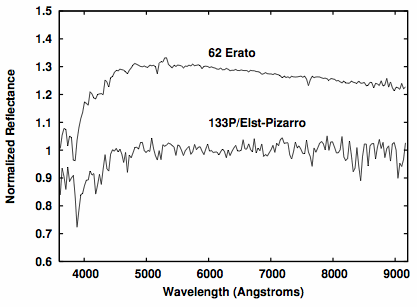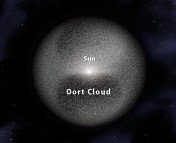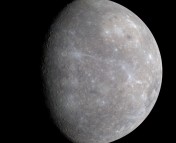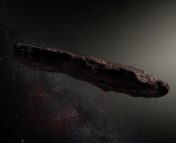Title: Testing the comet nature of main belt comets. The spectra of 133P/Elst-Pizarro and 176P/LINEAR.
Authors: J. Licandro, H. Campins, G. P. Tozzi, J. de Leon, N. Pinilla-Alonso, H. Boehnhardt, and O.R. Hainaut
First Author’s Institution: Instituto de Astrofisica de Canarias, Spain
Comets are kilometer-sized balls of ice and rock which make impressive displays when they pass near the Sun and ice sublimates off their surfaces. They are typically placed into two categories: short-period (periodic comets with orbital periods of less than 200 years) and long-period comets, which can take a million years to return to the inner Solar System. Comets in these two categories originate from different places in the Solar System, which is reflected in their respective orbital distributions. Long-period comets come from the Oort cloud and are isotropically distributed, while short-period comets primarily orbit near the ecliptic (i.e. in the same plane as the Earth and the Sun) and originate in the Kuiper belt, beyond Neptune’s orbit. Comets that pass near the Sun actively lose mass as they make their flashy visits, and therefore both long- and short-period comets must be constantly replenished from their respective reservoirs.

Two main belt comets; the comet-like tails can be seen. Other streaks in the image are background objects moving at different rates. Figure from the Hsieh & Jewitt discovery paper, 2006.
In 2006, however, Hsieh & Jewitt published the discovery of several main belt asteroids observed to have tails (just like comets do), which activate when nearest the Sun (just like comets do). Their work was motivated by the previous observation that asteroid 133P/Elst-Pizarro had a dust tail. This new population of “main belt comets” or MBCs originates from the asteroid belt between Mars and Jupiter. The objects in the figure above are not traditional comets but new MBCs.

Spectra of a Themis family asteroid (top) and an MBC (bottom) showing the similarity. The spectra are normalized and offset by a constant for clarity.
In this paper, the authors take visible-light spectra of two MBCs and three asteroids to determine whether MBCs are similar to traditional comets or asteroids. The asteroids picked for this sample are in the Themis family, which have orbits similar to those of the MBCs. The Themis family is thought to be the product of the break up of a single large parent asteroid and thus its members have similar compositions to each other (this was determined by the spectra and colors of the asteroids). Within the uncertainties, the spectra of the MBCs are similar to those of the Themis asteroids, but quite dissimilar from the spectrum of a traditional comet. This implies that the MBCs are members of the Themis family and lends support to the hypothesis that they are not of a traditional cometary origin.
The authors take a look at a couple of other neat things as well. First, they compare the spectrum of Phaeton, an “activated asteroid” in the Near Earth Asteroid (NEA) population with those of the MBCs; an activated asteroid is one with cometary activity, similar to what is observed in MBCs. Phaeton is thought to be a scattered member of another asteroid family (Pallas) and is compositionally inconsistent with a traditional cometary origin; they thus hypothesize that activated asteroids are scattered MBCs. Second, the authors looked for the presence of the CN molecule, which is a signature of water-ice sublimation, typically seen in traditional comets. They did not detect emission from gaseous CN. Assuming that water-ice sublimation is indeed the cause of activity, this means that gas emission is low and/or the molecular abundances in MBCs is much lower than in traditional comets.
Why do astronomers care about a new population of comets? First, this is yet one more piece in the puzzle that is our solar system and could help further our understanding of asteroid and comets, both in terms of their composition and evolution. Second, it has implications for how water was delivered to Earth: a new reservoir of icy bodies is another option for where our oceans come from. The origin of Earth’s water is a hotly debated topic and highly relevant to research on the origins of life.





